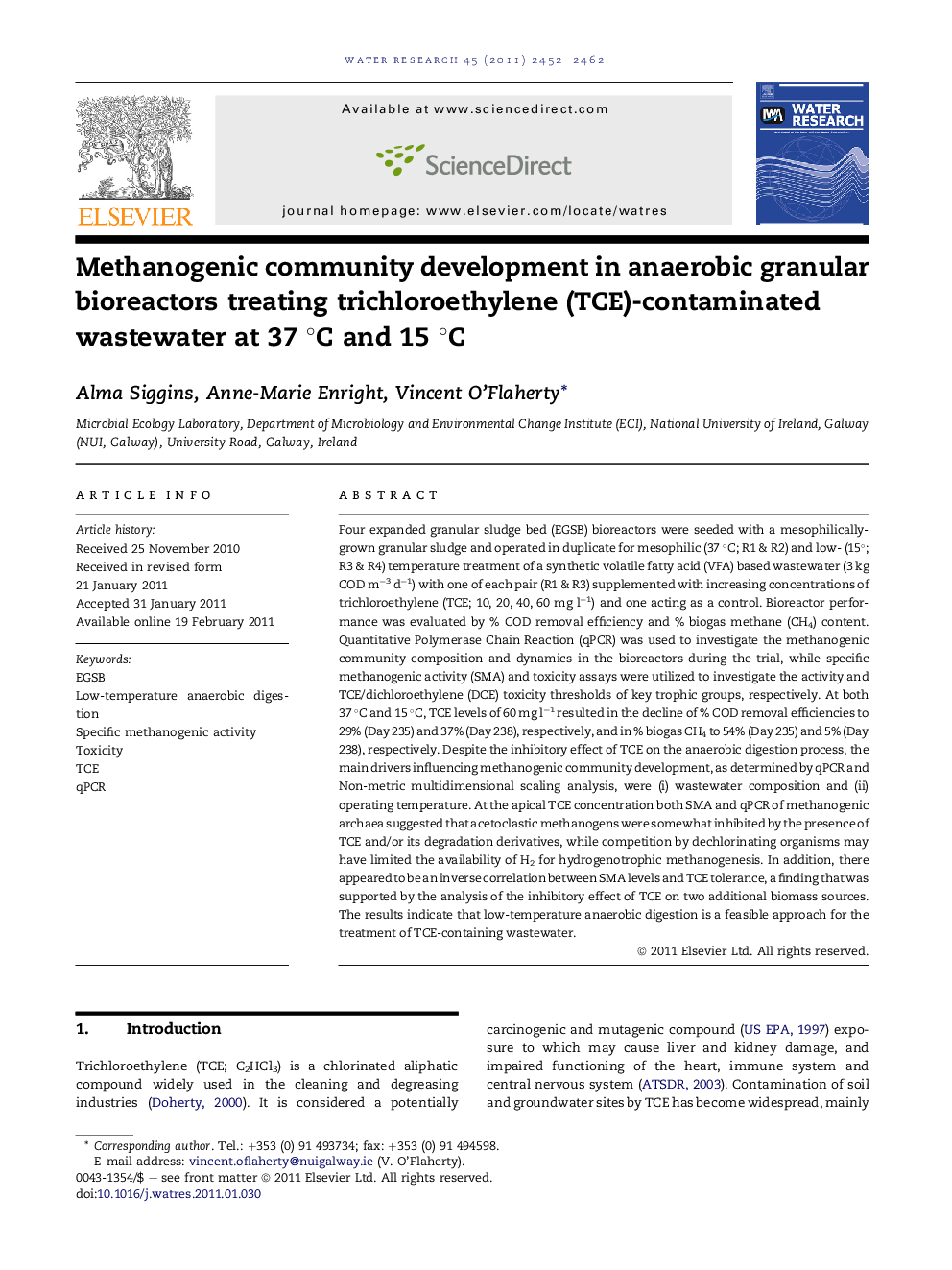| کد مقاله | کد نشریه | سال انتشار | مقاله انگلیسی | نسخه تمام متن |
|---|---|---|---|---|
| 4483570 | 1316892 | 2011 | 11 صفحه PDF | دانلود رایگان |

Four expanded granular sludge bed (EGSB) bioreactors were seeded with a mesophilically-grown granular sludge and operated in duplicate for mesophilic (37 °C; R1 & R2) and low- (15°; R3 & R4) temperature treatment of a synthetic volatile fatty acid (VFA) based wastewater (3 kg COD m−3 d−1) with one of each pair (R1 & R3) supplemented with increasing concentrations of trichloroethylene (TCE; 10, 20, 40, 60 mg l−1) and one acting as a control. Bioreactor performance was evaluated by % COD removal efficiency and % biogas methane (CH4) content. Quantitative Polymerase Chain Reaction (qPCR) was used to investigate the methanogenic community composition and dynamics in the bioreactors during the trial, while specific methanogenic activity (SMA) and toxicity assays were utilized to investigate the activity and TCE/dichloroethylene (DCE) toxicity thresholds of key trophic groups, respectively. At both 37 °C and 15 °C, TCE levels of 60 mg l−1 resulted in the decline of % COD removal efficiencies to 29% (Day 235) and 37% (Day 238), respectively, and in % biogas CH4 to 54% (Day 235) and 5% (Day 238), respectively. Despite the inhibitory effect of TCE on the anaerobic digestion process, the main drivers influencing methanogenic community development, as determined by qPCR and Non-metric multidimensional scaling analysis, were (i) wastewater composition and (ii) operating temperature. At the apical TCE concentration both SMA and qPCR of methanogenic archaea suggested that acetoclastic methanogens were somewhat inhibited by the presence of TCE and/or its degradation derivatives, while competition by dechlorinating organisms may have limited the availability of H2 for hydrogenotrophic methanogenesis. In addition, there appeared to be an inverse correlation between SMA levels and TCE tolerance, a finding that was supported by the analysis of the inhibitory effect of TCE on two additional biomass sources. The results indicate that low-temperature anaerobic digestion is a feasible approach for the treatment of TCE-containing wastewater.
► Continued stable bioreactor operation was obtained at both 37 °C and 15 °C, at influent TCE concentrations >60 mg l−1.
► At an influent concentration of 60 mg l−1, acetoclastic methanogens were directly inhibited by the presence of TCE or its degradation derivatives, while hydrogenotrophic methanogens may have been unsuccessful in the competition for H2 against other trophic groups.
► Methanogenesis and methanogenic community structure was strongly influenced by wastewater composition and also impacted by temperature.
► This study illustrated some potential difficulties with respect to the integration of quantitative molecular, physiological and anaerobic bioprocess data.
Journal: Water Research - Volume 45, Issue 8, April 2011, Pages 2452–2462